
Printer-Friendly Version (July/August 2007)
Los Angeles Launches Gang Reduction InitiativeIn April of this year, Los Angeles Mayor Antonio R. Villaraigosa announced the launch of a $168 million anti-gang initiative modeled on the Office of Juvenile Justice and Delinquency Prevention's (OJJDP's) Gang Reduction Program (GRP). Los Angeles was one of four cities selected by the U.S. Department of Justice in 2003 to implement the GRP model in pilot communities. The other cities are Richmond, VA; Milwaukee, WI; and North Miami Beach, FL. This new initiative in Los Angeles builds on the city's GRP pilot effort in the Boyle Heights neighborhood.
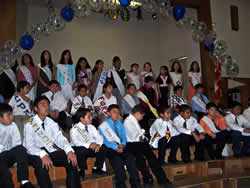 Fifth-graders at the Going on to College graduation ceremony. This gang prevention program focuses on the importance of higher education. |
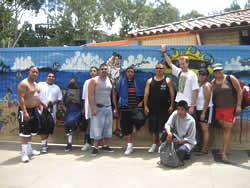 In Project Amiga, reformed gang members offer positive community support to youth entering gangs. |
- Primary prevention: focusing on the entire population in high-crime, high-risk communities.
- Secondary prevention: focusing on high-risk youth ages 7–14 to provide appropriate services for preventing onset of gang membership and other problem behaviors.
- Intervention: focusing on active gang members and their close associates to provide a combination of services and opportunities while holding these youth accountable for their actions.
- Reentry: focusing on gang-involved and other serious offenders who face multiple challenges to reentering their communities after confinement.
- Suppression: focusing on gang leaders to undertake aggressive prosecution efforts.
Boyle Heights and the other GRP pilot communities identified and coordinated resources, programs, and services to address known risk factors for delinquency in the community. They used grant funding to fill gaps so they could address risk factors across the broadest possible age spectrum.
Since 2003, the Boyle Heights neighborhood has experienced a 44-percent reduction in gang crime. The new initiative will draw on the pilot community's experience and approach to expand prevention efforts to other high-violence zones in Los Angeles. (Note: The statistics in this article are taken from the Mayor's office, City of Los Angeles, via the Los Angeles Police Department.)
According to Mayor Villaraigosa:
Of all the public safety challenges facing Los Angeles, street gangs have proven the most intractable. Our City is home to the largest and most established gang population in the country, with over 400 separate gangs and an estimated 39,000 gang members. These criminal gangs exact a tragic toll.... As a result, too many innocent Angelenos live in fear of indiscriminate gang violence resulting from petty disputes over drugs, turf, and revenge.
The Boyle Heights community's recent reduction in gang crime stands in contrast to citywide trends. In 2006, although overall crime in Los Angeles continued to decline for the fifth straight year, gang-related crime increased 14 percent. In that year alone, 56 percent of all homicides and 70 percent of all shootings in the city were gang related, 272 people lost their lives to gang violence, and more than 1,500 people were the victims of gang-related shootings.
In explaining his gang reduction strategy, Mayor Villaraigosa says:
The most effective way to address gang violence is through a comprehensive, collaborative, and community-wide approach. Our plan provides both a strong emphasis on enforcement with strategic development of programs and services focused toward communities with high at-risk populations. This solution is about community safety, community opportunity, and community empowerment.
|
OJJDP Celebrates National Youth Court Month
September 2007 is the sixth annual National Youth Court Month, held to focus the Nation's attention on an innovative program in which youth who commit minor offenses are sentenced by their peers. The theme for the 2007 event is "Empowering Youth... Experiencing Justice."
Youth courts, also known as teen courts or peer courts, affect the lives of youth in a unique and positive way. The courts hold juvenile offenders accountable for their actions, educate youth about the judicial and legal systems, empower youth to be active in their communities, and encourage positive behavior.
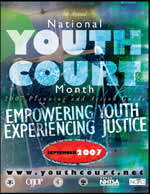 Youth courts typically accept minor offenses such as theft, vandalism, and disorderly conduct. Sentences vary widely and can include community service, restitution, jury duty, essay assignments, and educational workshops.
Youth courts typically accept minor offenses such as theft, vandalism, and disorderly conduct. Sentences vary widely and can include community service, restitution, jury duty, essay assignments, and educational workshops.
The Federal Youth Court Program, funded by the Office of Juvenile Justice and Delinquency Prevention (OJJDP), the National Highway Traffic Safety Administration, and the Office of Safe and Drug Free Schools, currently promotes the activities of some 1,300 youth court programs in 49 States and the District of Columbia. The National Association of Youth Courts (NAYC) serves as a central point of contact for these programs. NAYC manages an information clearinghouse, maintains a Web site, and provides national guidelines, training and technical assistance, and other services.
To learn more about youth courts, visit the NAYC Web site. At the Web site, click on the National Youth Court Month 2007 Action Kit icon for publicity and promotional materials, artwork, suggested activities, and other resources designed to help local youth courts involve community partners in the celebration of National Youth Court Month.
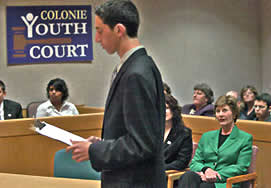 |
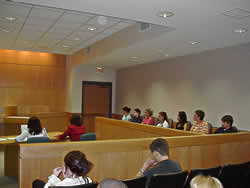 |
| "Prosecutor" Matt Bogdan delivers his opening statement in Youth Court as First Lady Laura Bush and other court attendees listen.
Photo provided by White House photographer, Sheelah Craighead. |
Children participate in Youth Court proceedings. |
DMC News
OJJDP Annual DMC Conference to Convene in October
OJJDP's 2007 national disproportionate minority contact (DMC) conference, "Reducing Disproportionate Minority Contact in Juvenile Justice by Making the Right Connections," will be held October 25–27, 2007 in Denver, CO.
The two-and-a-half day conference will provide State and local juvenile justice professionals with a variety of strategies to help make the right connections in their DMC-reduction efforts. The conference should be of particular interest to juvenile justice specialists, DMC coordinators, police officers, detention and probation professionals, family court judges, attorneys, and community-based youth services providers, including child welfare professionals. Presentations will focus on such topics as the following:
- Organizational strategies and structures that facilitate DMC-reduction efforts.
- Best practices and promising programs to reduce DMC.
- Rural solutions to reduce DMC in small communities.
The conference will be held at the Adam's Mark Hotel, 1550 Court Place, Denver, CO. For more information on registration, visit www.dsgonline.com/dmctraining.
OJJDP Seeks Nominations of Effective DMC Reduction Initiatives
OJJDP plans to expand its Model Programs Guide to include strategies and programs that are effective in reducing disproportionate minority contact. To this end, OJJDP is inviting nominations of DMC reduction initiatives believed to be effective.
Programs are eligible for nomination if they have been in operation for at least 2 years and data documenting effectiveness are available. OJJDP will review nominations for inclusion in a database of effective DMC initiatives and potential eventual addition to the Model Programs Guide.
The Model Programs Guide is designed to assist practitioners and communities in implementing evidence-based prevention and intervention programs that can make a difference in the lives of children and communities. Its database of evidence-based programs covers the entire continuum of youth services, from prevention through sanctions, to reentry. The Guide can be used to assist juvenile justice practitioners, administrators, and researchers to enhance accountability, ensure public safety, and reduce recidivism.
OJJDP-Sponsored Conferences Cover Host of Youth-Related Issues
New Orleans Conference Targeting Youth, Education, and Law
On September 6–8 in New Orleans, LA, the American Bar Association will conduct the National Law-Related Education (LRE) Leadership Conference. The theme of this year's conference, sponsored by OJJDP, is “Youth, Education, and Law: Current Issues, New Directions.” Participants will focus on the intersection of LRE, civic engagement, and public policy as they relate to empowering, protecting, and preparing young people for effective citizenship in our democratic society.
Plenary sessions will address the following subjects:
- Youth Rights—In and Outside of School.
- Immigration, Laws, and Families.
- The Future of Juvenile Justice.
- Civic Learning as a National Education Priority.
- Youth, Education, and Law in Katrina-Affected Areas.
For additional information, including a registration form, visit http://www.abanet.org/publiced/conference/lre07.html
Conference Highlights Juvenile Probation and Justice Management Issues
On September 9–12, in Albuquerque, NM, the National Council of Juvenile and Family Court Judges will conduct the Annual Juvenile Probation and Justice Management Conference.
Funded by OJJDP, the conference will include sessions on the following issues:
- Methamphetamines.
- Mental health abuse.
- Youth suicide.
- Juvenile sex offenders.
- Programming for girls.
- Detention alternatives.
For further information, including a conference brochure, and register online, visit http://www.ncjfcj.org/content/view/980/315.
National Conference Focuses on Safe Schools and Communities
On October 29–31, in Washington, DC, OJJDP, in connection with the Hamilton Fish Institute on School and Community Violence, will host the 2007 National Conference on Safe Schools and Communities.
OJJDP Administrator J. Robert Flores will deliver opening remarks and Regina B. Schofield, Assistant Attorney General, Office of Justice Programs, will deliver the keynote address, “The Role of Prevention Programs in Teen Violence and in Teen Relationships.”
Sessions will address the following subjects:
- Fostering bullying prevention strategies.
- Maintaining youth court programs.
- Implementing mentoring programs.
- Supporting community programs.
For registration and other information on the conference, visit http://gwired.gwu.edu/hamfish/AnnualConference/2007.
New Publications
All OJJDP publications may be viewed and downloaded at ojjdp.ncjrs.gov/publications. Print publications may also be ordered online at puborder.ncjrs.gov.
Now Available
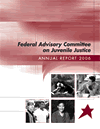 The 2006 Federal Advisory Committee on Juvenile Justice Annual Recommendations Report to the President and Congress of the United States is the committee's second annual report and outlines critical concerns and issues identified by FACJJ members. The report presents 10 recommendations that focus on the need for sufficient funding of OJJDP programs, the detrimental effects of earmarking Federal funds, and the need to amend the Juvenile Justice and Delinquency Prevention Act so that it operates more effectively and efficiently. (December 2006, NCJ 218367)
The 2006 Federal Advisory Committee on Juvenile Justice Annual Recommendations Report to the President and Congress of the United States is the committee's second annual report and outlines critical concerns and issues identified by FACJJ members. The report presents 10 recommendations that focus on the need for sufficient funding of OJJDP programs, the detrimental effects of earmarking Federal funds, and the need to amend the Juvenile Justice and Delinquency Prevention Act so that it operates more effectively and efficiently. (December 2006, NCJ 218367)
DVD on Juvenile Status Offenders
 OJJDP's national videoconference, “Addressing the Needs of Juvenile Status Offenders and Their Families,” which was originally broadcast on January 18, 2007, is now available on DVD. The conference focuses on the factors that may lead a status offender to become more deeply involved in serious risk behavior, offending, and the juvenile justice system. The broadcast highlights programs, practices, and policies that have shown promise in intervening with status offenders by reducing further offending, providing support to their families, and steering them toward a positive future.
OJJDP's national videoconference, “Addressing the Needs of Juvenile Status Offenders and Their Families,” which was originally broadcast on January 18, 2007, is now available on DVD. The conference focuses on the factors that may lead a status offender to become more deeply involved in serious risk behavior, offending, and the juvenile justice system. The broadcast highlights programs, practices, and policies that have shown promise in intervening with status offenders by reducing further offending, providing support to their families, and steering them toward a positive future.
In addition, the DVD features preconference videos on such topics as the family dynamic and early intervention, the key elements to a successful juvenile offense program, and ways to engage families in the prevention process diversion. The DVD also offers access to Web sites and publications on juvenile status offenders.
To order a copy of the DVD, go to www.ncjrs.gov, search for “NCJ 216888,” and click on the shopping cart icon.
Report Addresses Well-Being of America's Children
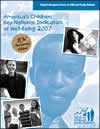 The Federal Interagency Forum on Child and Family Statistics has released America's Children: Key National Indicators of Well-Being, 2007, the U.S. Government's annual monitoring report on the well-being of the Nation's children and youth. OJJDP, along with Office of Justice Programs' sister agencies, the National Institute of Justice and the Bureau of Justice Statistics, are all Forum members who represent the Department of Justice.
The Federal Interagency Forum on Child and Family Statistics has released America's Children: Key National Indicators of Well-Being, 2007, the U.S. Government's annual monitoring report on the well-being of the Nation's children and youth. OJJDP, along with Office of Justice Programs' sister agencies, the National Institute of Justice and the Bureau of Justice Statistics, are all Forum members who represent the Department of Justice.
The report presents a comprehensive look at critical areas of child well-being, including family and social environment, economic circumstances, health care, physical environment and safety, behavior, and education and health. This year's report includes the following findings:
- The rate at which youth were perpetrators of serious violent crimes went up.
- The proportion of children living in physically inadequate or crowded housing or housing that cost more than 30 percent of household income rose.
- The adolescent birth rate has dropped to a record low.
- The proportion of children covered by health insurance has decreased.
To access the report, visit http://childstats.gov. Print copies are also available (NCJ 219130).
 News From the Coordinating Council on Juvenile Justice and Delinquency Prevention
News From the Coordinating Council on Juvenile Justice and Delinquency Prevention
The Coordinating Council on Juvenile Justice and Delinquency Prevention (Council) met most recently on June 8, 2007, at the U.S. Department of Agriculture. The quarterly meeting featured a panel discussion on 4-H partnerships with the U.S. Army and Air Force. The next meeting will be held September 14, 2007 at the U.S. Department of Labor. For meeting summaries, information about the Council's mission, and links to related resources, visit the Council's Web site at juvenilecouncil.gov.
Special Report: 4-H Teams Up With U.S. Army and Air Force
The June 8 Council meeting featured a panel discussion about the U.S. Department of Agriculture's (USDA's) 4-H Program and its longstanding relationship with the U.S. Army and Air Force.
|
Brooke Borelli, a sixth-grader and 4-H member at Bolling Air Force Base, explained that she and her family have moved seven times. "Changing schools and leaving friends behind is a hassle," she said. "I try to make a good friend everywhere I go, and 4-H helps make that happen." As with many military children, Brooke's mother has been deployed to Iraq.
The emotional cost of having a parent deployed overseas is high, according to Angela Huebner, Associate Professor, Department of Human Development, Virginia Polytechnic and State University. Dr. Huebner summarized the findings from a study supported by the Military Family Research Institute and the U.S. Department of Defense's Quality of Life Office that examined how adolescents in military families adapt when a parent is deployed.
"There is a lot of stress," she said. "Youth at those ages are going through enough normative changes as it is. Add to that an unstable family situation." Such children are very tuned into the stress of the at-home parents, as well. Many have a strong sense of wanting to protect the rest of the family. "In a way, they become little adults, taking on many new responsibilities at home," she said. Adolescents also demonstrated a great deal of resiliency when it comes to dealing with changes in their daily lives. Though their parent's deployment was a negative event in their lives, adolescents exhibited numerous adaptive responses. Nevertheless, other adolescents reported symptoms consistent with depression.
Eliza Nesmith, Chief, Community Programs, U.S. Air Force, said that State 4-H Military Liaisons coordinate work with Air Force Youth Programs and county 4-H staff to establish 4-H clubs on Air Force bases around the world. She attributed the following factors to achieving successful partnerships with 4-H:
- Finding common ground with partner groups.
- Developing and using positive personal contacts and relationships.
- Avoiding bureaucracy, when possible, and keeping management teams small.
- Having people at the table who have the authority to make decisions.
- Identifying a clear vision and keeping goals small and achievable.
- Meeting regularly to evaluate and reevaluate the status of the project.
- Building in sustainability of funding and other resources.
For more information on 4-H/military partnerships, visit: www.4hmilitarypartnerships.org.
|
|
|
 News From the Federal Advisory Committee on Juvenile Justice
News From the Federal Advisory Committee on Juvenile Justice
The next meeting of the Federal Advisory Committee (FACJJ) will be held Sunday and Monday, October 21 and 22, in conjunction with OJJDP's combined training for FACJJ and State Advisory Group members, juvenile justice specialists, disproportionate minority contact (DMC) coordinators, compliance monitors, and Targeted Community Action Planning coordinators, and with the annual DMC conference. The combined training will be held Tuesday and Wednesday, October 23–24, followed by the 2007 annual DMC conference, "Making the Right Connections," Thursday through Saturday, October 25–27. Meeting summaries and other information about the Advisory Committee are available on the Committee's Web site.
The Committee is a consultative body established by the Juvenile Justice and Delinquency Prevention Act of 2002 and supported by OJJDP. Composed of representatives nominated by the Governors of the States and territories and the mayor of the District of Columbia, the Committee advises the President and Congress on matters related to juvenile justice, evaluates the progress and accomplishments of juvenile justice activities and projects, and advises the OJJDP Administrator on the work of OJJDP.
Now Available
 The 2006 Federal Advisory Committee on Juvenile Justice Annual Recommendations Report to the President and Congress of the United States is the Committee's second annual report and outlines critical concerns and issues identified by FACJJ members. The report presents 10 recommendations that focus on the need for sufficient funding of OJJDP programs, the detrimental effects of earmarking Federal funds, and the need to amend the Juvenile Justice and Delinquency Prevention Act so that it operates more effectively and efficiently. (December 2006, NCJ 218367)
The 2006 Federal Advisory Committee on Juvenile Justice Annual Recommendations Report to the President and Congress of the United States is the Committee's second annual report and outlines critical concerns and issues identified by FACJJ members. The report presents 10 recommendations that focus on the need for sufficient funding of OJJDP programs, the detrimental effects of earmarking Federal funds, and the need to amend the Juvenile Justice and Delinquency Prevention Act so that it operates more effectively and efficiently. (December 2006, NCJ 218367)
State Contacts | Publications | Statistics | Events
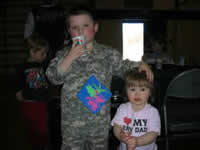
 Children from Operation Military Kids reach out to parents overseas.
Children from Operation Military Kids reach out to parents overseas.